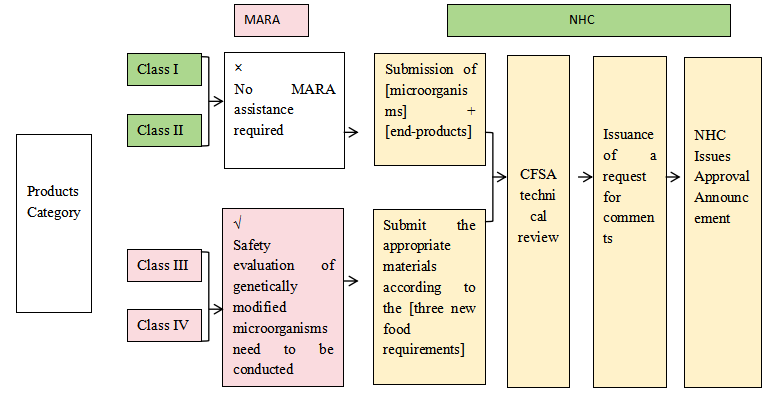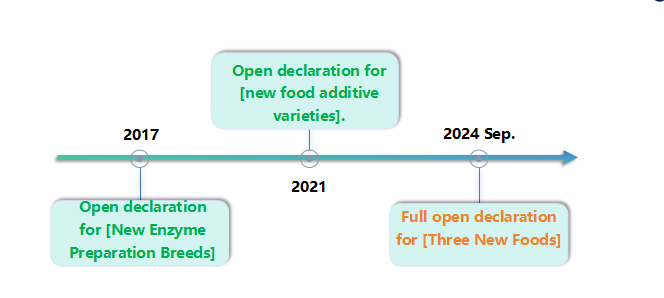On September 13, 2024, the National Center for Food Safety Risk Assessment (CFSA) issued the Requirements for Declaration Materials for Safety Evaluation of Genetically Modified Microorganisms for Food Processing (Trial) (hereinafter referred to as the Requirements for Declaration Materials (Trial), which indicates that new products produced by microorganisms modified by genetic engineering technology have been fully open for declaration of the three new food products (including new food raw materials, new varieties of food additives and new varieties of food-related products).
According to its experience of declaration, the food team at CIRS will provide you with a quick understanding of the latest declaration requirements for these kinds of products.
What are products produced by genetically modified microorganisms (GMMs) for food processing?
Compared with the products produced by chemical synthesis, extraction, and other traditional processes, the products produced by GMMs for food processing can generally be understood as new food ingredients, new food additives, new food-related products produced by microorganisms that have changed their genome structure by using genetic engineering technology.
What are the specific classifications of products?
The Requirements for Declaration Materials (Trial) mentions that the products are classified according to the composition of the products, test data such as the content of target products, test data of exogenous gene residues in the products, test data of genetically modified microorganisms' residues in the products, data, and reports on the environmental risk control measures and effects: Class Ⅰ is purified products, and Class Ⅱ is composite products. According to our previous experience, the products produced by genetically modified microorganisms can be divided into four categories:
|
Categories |
Class Ⅰ |
Class II |
Class III |
Class IV |
|
Product Properties |
Purified Products |
Complex Products |
Dead Bacteria |
Live Bacteria |
|
Chemical characterization |
Clear structure, purity, and composition |
Not entirely clear |
/ |
/ |
|
Does the product contain newly introduced gene fragments? |
No |
No |
Yes |
Yes |
|
Does the product contain genetically modified microorganisms? |
No |
No |
Yes, but can not be proliferated or metastasized |
Yes, can be proliferated or metastasized |
|
Examples of products |
Breast milk oligosaccharides, amino acids, vitamins |
Most enzymes |
Yeast with expression in soy leghemoglobin |
live fermenter |
Declaration pathways for different products
When China opened the declaration channel for genetically modified microorganisms for new food additives in 2021, these products needed to be evaluated by two regulatory authorities: the National Health Commission (NHC) and the Ministry of Agriculture and Rural Affairs (MARA).
With the release of Requirements for Declaration Materials (Trial), according to the different product classifications of enterprises, the declaration paths will be different: Class I and Class II will only need to go through the review and approval of the National Health and Health Commission.
According to CIRS' understanding, Class III and Class IV will still be a two-step process: they need to pass the safety assessment of the Ministry of Agriculture and Rural Affairs first, and then be submitted to the National Health Commission for review and approval.
The details are as follows:

Declaration requirements for Class I and Class II products (microorganisms)
According to the Requirements for Declaration Materials (Trial), Class I and Class II products involving genetically modified microorganisms are required to submit the following relevant contents:
|
Related Information for product category |
1.1 Composition of the products, the content of target products, and other test data. |
|
1.2 Exogenous gene residue detection data in the product. |
|
|
1.3 Detection data of genetically modified microbial residues in products. |
|
|
1.4 Environmental risk control measures and effects |
|
|
1.5 Description of Product Classification |
|
|
Related Information for Genetically Modified Microorganisms |
2.1 Basic information |
|
2.2 Taxonomic and identification information |
|
|
2.3 Biological characteristics |
|
|
2.4 Information on environmental conditions |
|
|
2.5 Information on other national regulations |
|
|
2.6 Safety Evaluation of Genetically Modified Microorganisms for Food Processing |
|
|
Safety evaluation of receptor microorganisms |
3.1 Background Information |
|
3.2 Biological Characteristics |
|
|
3.3 Adapted Ecological Environments |
|
|
3.4 Genetic Variation |
|
|
3.5 Other Information |
|
|
3.6 Safety Levels |
|
|
Safety evaluation of genetic manipulation |
4.1 Description of traits and characteristics introduced or modified in genetically modified microorganisms for food processing |
|
4.2 Information on actual insertion or deletion of sequences |
|
|
4.3 Vector information |
|
|
4.4 Information on each fragment of the insertion region in the vector |
|
|
4.5 Methods of genetic manipulation |
|
|
4.6 Genetic stability |
|
|
4.7 Techniques for detection and identification of target genes |
|
|
4.8 Determination of safe types of genetic manipulation |
CIRS Tips
① In addition to the above information, the final product should provide relevant materials in accordance with the three new food declarations and acceptance of the relevant provisions.
②The declaration materials of Class III and Class IV products should also provide relevant information according to the requirements of Agricultural Genetically Modified Organisms Safety Certificate by stages.
Review of the history of the development of the related laws
In China, the declaration of three new foods produced by GMMs for food processing is gradually opening up.
- In 2017, only new varieties of genetically modified microorganism enzyme preparations were accepted for declaration.
- In 2021, the declaration of genetically modified microorganism food additives was added.
- With the continuous development of synthetic biology technology and policy support, in September 2024, the national regulatory authorities officially opened the declaration channel for three new foods produced by genetically modified microorganisms for food processing.

About CIRS
CIRS has a professional three new food technology team, with rich experience and many successful cases in the field of three new foods (new food raw materials, new varieties of food additives, and new substances of food-related products).
CIRS has represented dozens of new raw materials and additives produced by genetically modified microorganisms for food processing, and has many successful cases (including breast milk oligosaccharides, steviol glycosides, and enzymes), and the project experience is at the forefront of the industry.
If you need any assistance or have any questions, please get in touch with us via service@hfoushi.com.

